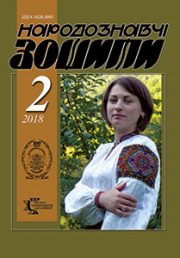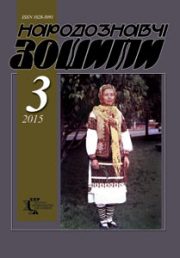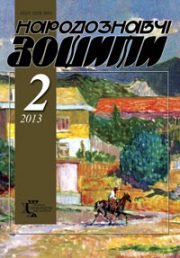The Ethnology Notebooks. 2022. № 4 (166), 928—937
UDK 746(=161.2):005.33 “20”
DOI https://doi.org/10.15407/nz2022.04.928
SEMCHUK Lesia
- ORCID ID: https://orcid.org/0000-0002-3209-3585
- Candidate of Art History, Associate Professor,
- Vasyl Stefanyk Precarpathian National University,
- Design and Theory of Art,
- 57, Shevchenka st., Ivano-Frankivsk, 76000, Ukraine,
- Contacts: e-mail: lesia.semchuk@pnu.edu.ua
Abstract. Introduction. Embroidery is an important component of the artistic system of Ukrainian folk clothing. It always reflected the aesthetic preferences of Ukrainians and was sensitive to various historical and cultural influences. As a result of the socio-political processes that took place on the territory of Ukraine at the turn of the millennium, interest in folk art, in particular — in clothing embroidery, is growing in Ukrainian society.
Formulation of the problem. This led to a great demand for embroidered clothes and caused the saturation of the market with cheap, machine-embroidered products with signs of the intervention of elements and colors, uncharacteristic of Ukrainian folk clothing.
On this background, at the beginning of the 21st century, interest in authentic embroidered shirts is growing among the population. Various groups and associations are organized, which, within the framework of commercial activities, offer master classes on learning embroidery techniques, embroidery schemes, original embroidered products, etc. Some of them, without going beyond the commercialization of services, focus on the idea of reviving regional features of authentic Ukrainian clothing embroidery.
Goal. The study highlights the history of the establishment and development of the Lviv art space «Magda Dzvin’s Workshop» in the aspect of the revival of traditional Ukrainian clothing embroidery at the beginning of the 21st century.
The research methodology is based on interviewing, structuring and comparison, as well as historical and communication aspects of system analysis. As a result of the study, several areas of activity of the workshop were outlined — collecting, educational and research activities. The stages of development, the processes of finding educational formats, methodical approaches, their features depending on public demand are analyzed.
Conclusion. During its eight-year activity, «Magda Dzvin’s Workshop» attracted the attention of hundreds of interested Ukrainians and became an important socio-cultural environment that forms an understanding of tradition. Despite the study of various types of folk art, the main direction of her activity remains the collection and revival of authentic clothing embroidery.
Keywords: clothing embroidery, «Magda Dzvin’s Workshop», art space, embroidery techniques, stitching methods, embroidery art, performance skills, educational formats.
Received 2.08.2022
REFERENCES
- Babii, N., Chmelyk, I., Semchuk, L., & Typchuk, V. (2022). Art practices in museums of Western Ukraine — from subject to method. AD ALTA: Journal of Interdisciplinary Research (Vol. 12, issue 1, pp. 91—98).
- Zakharchuk-Chuhai, R. (1988). Ukrainian folk embroidery: western regions of the USSR. Kyiv [in Ukrainian].
- Kara-Vasyl’ieva, T. (2008). History of Ukrainian embroidery: book-album. Kyiv: Mystetstvo [in Ukrainian].
- Selivachov, M. (2005). Lexicon of Ukrainian ornamentation (iconography, nomination, stylistics, typology). Kyiv [in Ukrainian].
- Shudria, Ye. (2003). Folk art ascetic. Kyiv: Ant [in Ukra inian].
- Lviv poetess Magda Dzvin presents her new collection «We Are Now» in Khmelnytskyi. Retrieved from: https://ye.ua/news/news_27882.html (Last accessed: 6.05.2022).
- Kryshtaleva, O. Authenticity from the workshop of Magda Dzvin. Retrieved from: https://korali.info/obryadi/avtentika-vid-maisterni-magdi-dzvin.html (Last accessed: 18.02.2022).
- Stefanchuk, U. 12 ZUMstrich (Zoom-meeting) about embroidery: Anna Rohatynska and Oksana Pecharska Magda Dzvin Workshop (Lviv). Retrieved from: https://www.youtube.com/watch?v=J5HDHUx2z-A (Last accessed: 06.06.2022).
- Stefanchuk, U. 9 ZUMstrich (Zoom-meeting) about embroidery: Yaryna Slipetska (Lviv) about restoration, embroidery as a marker and education of taste. Retrieved from: https://www.youtube.com/watch?v=iPUsSqswVV8 (Last accessed: 06.06.2022)
- Vovk, F. (2015). Studies of Ukrainian ethnography and anthropology. Kharkiv: Savchuk O.O. [in Ukrainian].
- Biliashivs’kyj, M.F. (2017). Ukrainian folk art. Kharkiv: Oleksandr Savchuk [in Ukrainian].
- Shukhevych, V.O. (2018). Hutsul region: in 5 parts. Kharkiv: Oleksandr Savchuk [in Ukrainian].
- Hurhula, I. (1966). Folk art of the Western regions of Ukraine. Kyiv: Mystetstvo [in Ukrainian].
- Kul’chyts’ka, O. (2018). Folk clothes of Western regions of Ukraine. L’viv: Apriori [in Ukrainian].
- Kulynych-Stakhurs’ka, O. (1996). The art of Ukrainian embroidery: Technique and technology. L’viv: Misioner [in Ukrainian].
- Stel’maschuk, H. (2019). Ukrainian national costume. L’viv: Apriori [in Ukrainian].
- Nykorak, O. (2004). Ukrainian folk fabric of the 19th and 20th centuries: Typology, localization, artistic features. L’viv [in Ukrainian].
- Vrochyns’ka, H. (2008). Ukrainian folk women’s accessories of the 19th century — beginning 20th century. Kyiv: Rodovid [in Ukrainian].
- Bulhakova-Sytnyk, L. (2005). Podillya traditional folk embroidery: ethnographic aspect. Lviv [in Ukrainian].
- Kosmina, O. (2008). Traditional clothing of Ukrainians. Kyiv: Baltiia-Druk [in Ukrainian].
- Man’ko, V. (2008). Ukrainian folk Easter egg. L’viv: Svichado [in Ukrainian].
- Interview with A.L. Rohatynska: audio recording 05.05.2022. Archive of L. Semchuk. Ivano-Frankivsk [in Ukrainian].
- Workshop of Magda Dzvin. Retrieved from: https://www.facebook.com/majsterniamagdydzvin/events/?ref=page_internal (Last accessed: 06.07.2022).






